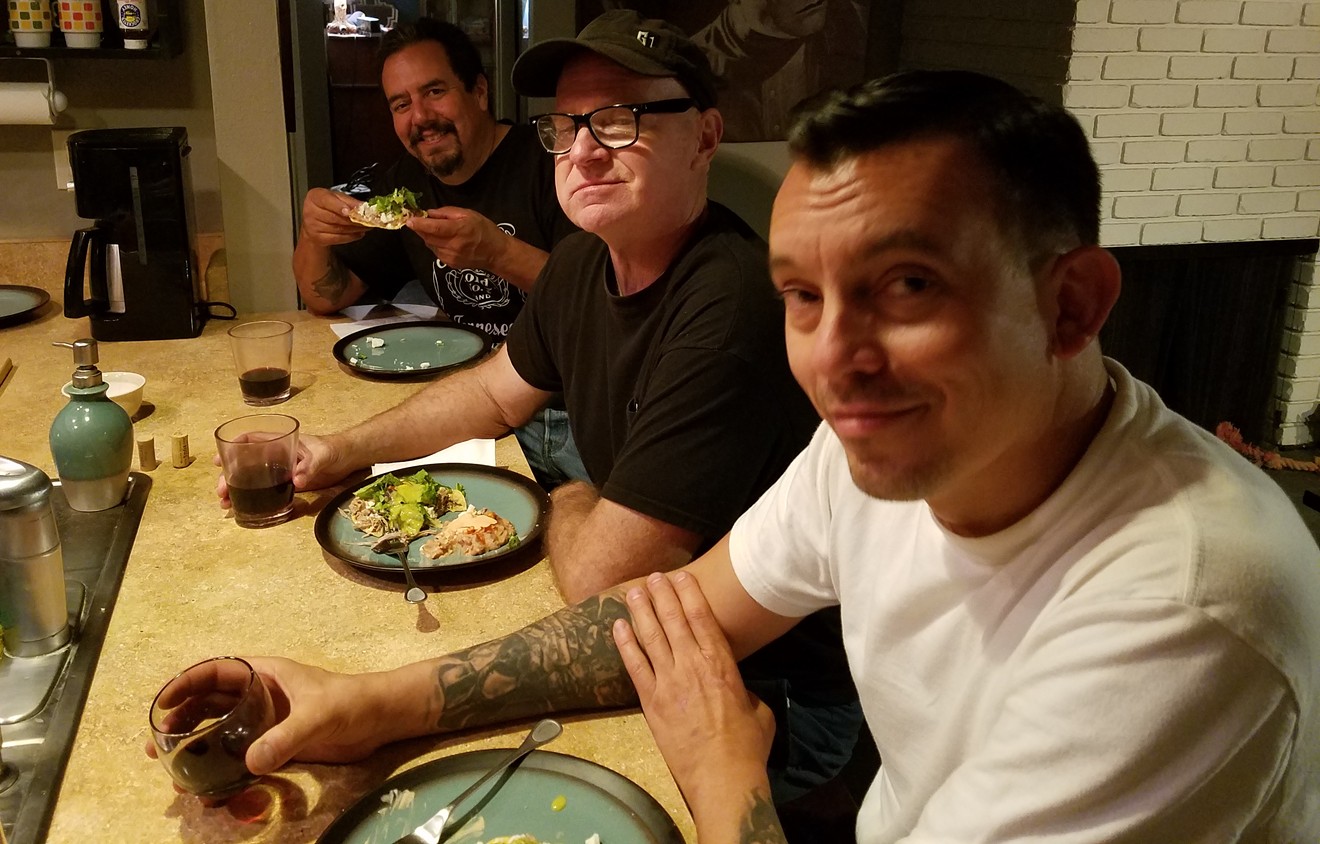If you’re new to this 25-years-strong roots and alt-country band, don’t try to Google them. Flathead is not Web-friendly, and for fans, friends, and those just familiar, that sounds about right. If you want to know more about Flathead, you’re welcome to join the turned-up crowd at one of Flathead's high energy, honky-tonk style shows.
Flathead has earned some of the most fun genre titles out there, which is no surprise as they’ve been at this since 1993. Flathead’s music has been labeled everything from roots punk to rig rock to downright country.
We caught up with the two original members, guitarist and vocalist Greg Swanholm, and drummer and backup vocalist Vince Ramirez, at one of their favorite spots (the east-facing side of Casey Moore’s inside bar) to talk about the early days of Flathead as a duo, a trio, and beyond.
“To me it’s hard to clarify,” says Ramirez, on the topic of Flathead’s most suitable genre. “When Swanholm and I started this 26 years ago, all’s we did was play songs we happen to know, like, ‘I know this Johnny Cash song.’ ‘Well, I know this Johnny Cash song.’”
Ramirez moved from Kansas and happened to meet Swanholm in the early '90s during the heyday of the Tempe sound. He says the two had no aspirations in terms of any particular genre, “We just created the sound that we did.”
The first time the two ever jammed was at a furniture store in Scottsdale after hours. They taped a microphone to a furniture dolly for Swanholm. “It was cool,” says Ramirez, “We were just having fun. We weren’t trying to be a band or anything.”
Original songs came next, and easy, thanks to circumstances like Swanholm’s father being a truck driver (think the windows-down country track “Hated the Road”). He and Ramirez would practice anywhere they could. “We ended up singing in a kitchen and it had this great sound,” he says, “It was just us and the dirty dishes, I guess.”
Swanholm says they next started trading originals, and that’s when harmonies started popping up. Ramirez says he never sang much, but Swanholm encouraged him. Their sound “kind of descended on us,” Swanholm explains. “So, we kept going to the kitchen.”
Harmony-heavy jams, like “Lordy Mercy” and “Alcoholin’,” followed. Says Swanholm, “Again, I don’t think we thought too much about making it anything more than that.”
However, Ramirez says they started getting better and began booking gigs and parties. Their first show was November 7, 1992, at the Rhythm Room as a duo.
“People seemed to dig it, but then they kept saying, ‘When are you going to get a bass player and be a real band?’” he says laughing, “and we thought we were a real band.”
Swanholm echoes, “We were pretty real.”
“Obviously this was way before White Stripes,” says Ramirez.
They eventually took out an ad in Phoenix New Times for a bass player. The responses ran the gamut.
They reminisce about a heavy-metal guy who showed up with a Steinberger guitar. Swanholm let him know they were more into a country sound. The guy proceed to shred and wail and screech, “and then he sits back like he killed it,” says Swanholm laughing. “What do you do with that?”
It was soon after this incident that a friend recommended his girlfriend’s sister, a bass player named Ruth Wilson.
“We called her up and she showed up half an hour later in cut-off shorts and cowboy boots,” says Ramirez. “Punk-rock chick. Chewing gum. She showed up with her bass and started playing. And it was exactly what we wanted.”
Swanholm agrees. “Astute, clean, deliberate,” he says, “It was like, ‘Really?’ Cancel the ad, man.”
They were a trio.
What happened next is more Phoenix music-scene history. Ramirez worked for the mother of Curt and Cris Kirkwood, a.k.a the Meat Puppets brothers. When she heard of Ramirez’s band, she got Curt Kirkwood on the phone. She asked when their next show was, which happened to be in a week at the Mason Jar.
“They’re called Flathead and they’re going to play for you,” Ramirez recalls hearing her tell the brothers.
There was a lot of work to do before the show. Wilson had to learn about 15 songs in a week, “and she did,” says Swanholm.
The first show as Flathead, and as a trio, was February 6, 1993.
The music scene in 1993 was full-on Mill Avenue action, Swanholm explains. Wong’s was in full swing, as was the Sail Inn, Balboa Café, Hayden Square, Yucca Tap Room – the list goes on. Bands like the Gin Blossoms and Dead Hot Workshop were the acts to beat.
“It kind of helped propel us, because what we were doing was something really unlike the rest of the Tempe music scene,” Ramirez says, “but people embraced it because it was different, and at the same time we knew a lot of those dudes.” Swanholm adds, “So [Flathead] still fit.”
The two then list off about a million friends and music venues from that time.
Over the next 25 years, Flathead had seven bass players in total. The band continued making albums in makeshift studios – 1996’s Flathead, 1999’s Play the Good One, and 2011’s Get It Said – and playing shows.
Today, Flathead plays but a few shows a year. The 2018 calendar included a rowdy daytime headlining at Yucca Tap Room in February, which celebrated their 25th anniversary as a band. Ramirez was proud to announce that four of seven bass players were at the show – including current bassist Alex Otto.
Swanholm and Ramirez agree they may enjoy getting together to practice for shows – often at Ramirez’s son's studio in Tempe – more than the show. “No offense to the people coming to the shows,” he says, “It’s just that, we’re a family and it’s like a family reunion every time we get together.”
The band catch up, drink beer, and often grill up some steaks. “And we happen to get together and play a little music, too,” says Swanholm. Ramirez has even started the tradition of photographing them eating dinner instead of practicing, and posting on the Flathead Instagram, often with some version of the caption: “Looks like another Flathead show is coming up.”
The two attribute the slowdown in gigs to life — Ramirez now lives in Casa Grande, and Swanholm has had a recurring arm injury. Despite the pace of upcoming shows, Swanholm says he writes constantly, but they haven’t had the opportunity to put things into play.
Ramirez says they’ve been known to woodshed new music for up to five years at a time. Swanholm agrees. “Right now we just can’t get to it, but it’s there, and it’s always going to be there,” he says, “It’s something we always end up coming back to.”
So how has the music progressed? “I don’t think it’s progressed a bit,” says Swanholm. Ramirez agrees. “It was what it was, and it still is what it was,” he says. Swanholm explains, “It’s the same thing that always seems to show up; the same thing that showed up in the kitchen in 1992 can show up tomorrow or a year from now,” he says, “and that’s the cool part about it.”
And how has the crowd progressed? This question prompts laughing. “Not a bit,” Swanholm says. Agrees Ramirez, “Yeah, same old ugly faces every time.“
[
{
"name": "Air - MediumRectangle - Inline Content - Mobile Display Size",
"component": "18478561",
"insertPoint": "2",
"requiredCountToDisplay": "2"
},{
"name": "Editor Picks",
"component": "16759093",
"insertPoint": "4",
"requiredCountToDisplay": "1"
},{
"name": "Inline Links",
"component": "17980324",
"insertPoint": "8th",
"startingPoint": 8,
"requiredCountToDisplay": "7",
"maxInsertions": 25
},{
"name": "Air - MediumRectangle - Combo - Inline Content",
"component": "16759092",
"insertPoint": "8th",
"startingPoint": 8,
"requiredCountToDisplay": "7",
"maxInsertions": 25
},{
"name": "Inline Links",
"component": "17980324",
"insertPoint": "8th",
"startingPoint": 12,
"requiredCountToDisplay": "11",
"maxInsertions": 24
},{
"name": "Air - Leaderboard Tower - Combo - Inline Content",
"component": "16759094",
"insertPoint": "8th",
"startingPoint": 12,
"requiredCountToDisplay": "11",
"maxInsertions": 24
}
]












